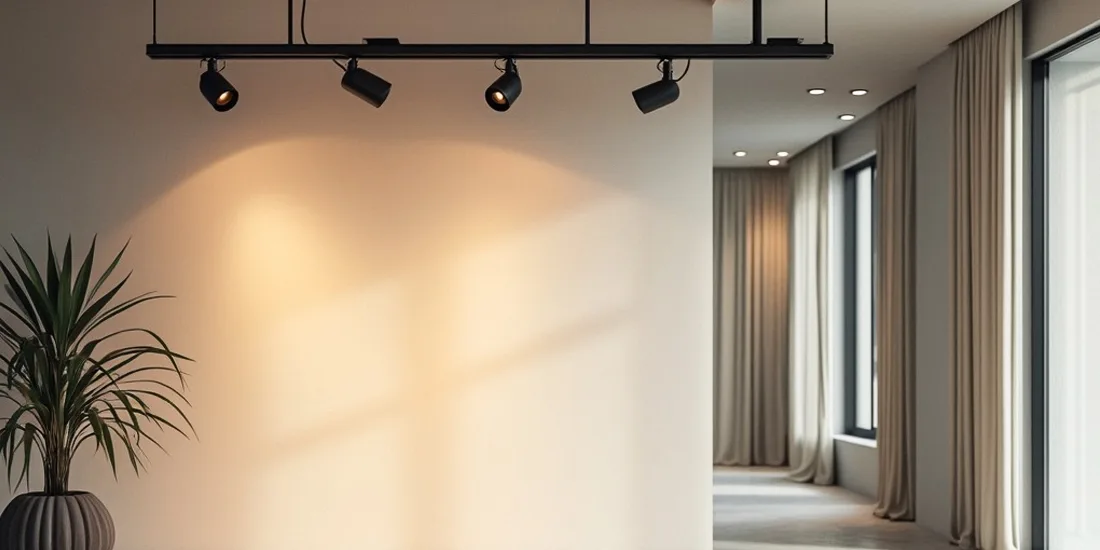When it comes to illuminating a space, track lighting has long been a versatile and stylish option. It allows for flexible and targeted lighting, therefore, it is widely used in residential and commercial settings.
However, when deciding between recessed track lighting and traditional track lighting, a number of factors must be considered, including aesthetic preferences, installation requirements, and lighting performance. Each type has its distinct advantages and may suit different interior design needs.
Traditional track lighting consists of a mounted track, typically installed along the ceiling, with adjustable light fixtures or heads. These fixtures can be positioned along the track, allowing users to direct the light precisely where it is needed.
Traditional track lighting is known for its exposed and industrial look, with the track and bulbs visible as part of the overall design. This style has been popular for decades and remains a go-to choice for modern homes, offices, and galleries due to its functional versatility and straightforward installation.
Recessed track lighting, as the name suggests, takes the concept of traditional track lighting but incorporates it into the ceiling itself. Rather than being mounted on the surface, recessed track lighting is installed within a specially designed ceiling cavity, so the track is hidden, and only the light fixtures are visible.
Recessed track systems often use similar technology to traditional track lighting, with adjustable light heads that can be positioned to illuminate specific areas. However, the track is concealed within the ceiling, giving the room a cleaner, less cluttered appearance.
One of the most obvious differences between regular track lighting and recessed track lighting is their aesthetics. Traditional track lighting is frequently linked to a more functional or industrial aesthetic. It can provide a striking impression in the space because the track and light heads are usually visible. In areas like lofts, galleries, or creative studios that have a more contemporary or urban feel, this can be particularly alluring.
On the other hand, recessed track lighting provides a more subtle, integrated appearance. Because of the recessed placement, the light fixtures blend in perfectly with the surrounding architecture and almost seem like they are a part of the ceiling. This kind of track lighting is frequently preferred in areas like contemporary kitchens where a simple, minimalist appearance is preferred.
Although it does require a mounting system that fastens to the ceiling surface, installing traditional track lighting is rather easy. For other ceiling types, such as plaster or drywall, it might be necessary to drill into the ceiling in order to secure the track, which can take more work. The track is a versatile option for many interior layouts because of its visibility, which reduces installation limits.
Recessed track lighting installation, on the other hand, is more difficult. Before the tracks are placed, a recessed housing needs to be constructed in the ceiling. Therefore, major renovations or new construction are better suited for recessed track lighting.
Recessed track lighting can be more difficult to maintain. It could take a little effort to get to the recessed track, particularly if it has to be replaced or repaired. Traditional track lighting makes cleaning, repairing, and replacing tracks and fixtures easier because they are surface mounted.

Both recessed and traditional track lighting excel at providing directional lighting, ideal for highlighting artwork, creating task lighting for workspaces, or setting a specific mood.
Recessed track lighting is often more fixed in its design. While the lights can often be adjusted or angled, the flush design can limit the types of fixtures you will be able to use. It can still provide great functionality for focused or ambient lighting, especially in kitchens, galleries, and offices.
Traditional track lighting is much more flexible. First, the tracks themselves support a wide array of fixture options, from spotlights and pendants to even decorative hanging lights. In addition, it is extremely easy to add or remove fixtures, or reposition them along the track, making the system highly adaptable to changing needs or tastes.
Because it requires specialized equipment and is labor-intensive to install, recessed track lighting is typically more expensive. Installation fees can raise the total cost considerably, making it a bigger investment. In general, traditional track lighting is less expensive. If you hire a professional or even do it yourself, you can save labor costs because the materials are frequently less expensive and the installation process is simpler.
Both recessed track lighting and traditional track lighting offer excellent lighting and versatility. While traditional track lighting offers unparalleled flexibility and ease of installation, recessed track lighting offers a stylish, minimalist aesthetic. Ultimately, the choice between recessed and traditional track lighting depends on your specific needs and preferences.